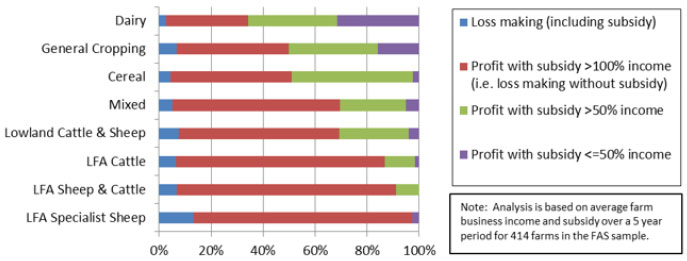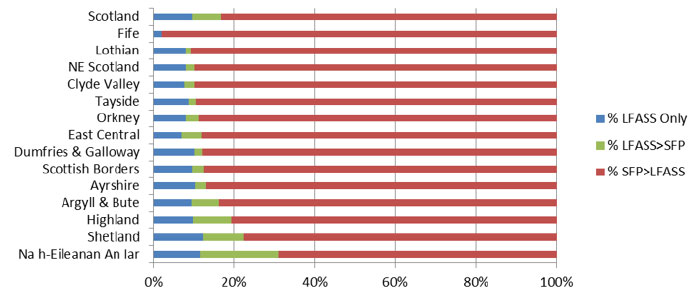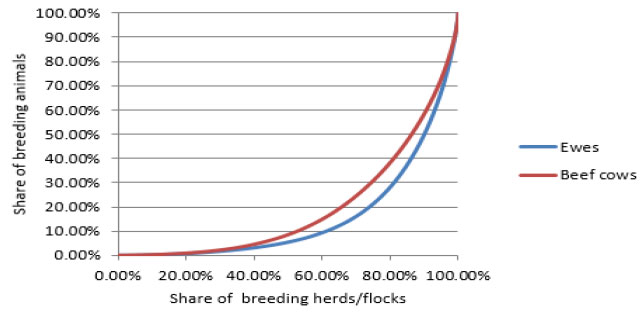Evaluation of less favoured area support scheme
Report to help inform preparations for the transition from Less Favoured Areas (LFAs) to Areas of Natural Constraint (ANCs).
5. Sustainable farming systems & business viability
Introduction
65. All of the evidence provided by the SG confirms that the type of farming systems currently dominant across the LFA are not commercially viable. Specifically, cattle and sheep enterprises typically incur not only negative net margins but often negative gross margins, revealing that market returns are not sufficient to cover even variable costs, let alone fixed costs (although this problem is not unique to LFA farms).
66. The persistence of loss-making enterprises implies a high degree of dependence on cross-subsidy from other funding sources, either private and/or public. Private sources include diversified on-farm income (e.g. tourism, forestry) and off-farm income (e.g. employment, investments, pensions) and are related to factors other than land quality (e.g. skills, accessibility, local labour markets). At a business or household level, a portfolio of income sources may deliver greater sustainability than is apparent at the enterprise level. However, household income data are not readily available.
67. Private cross-subsidisation might reflect attitudes to risk (e.g. uncorrelated, diversified income streams), lifestyle choices (i.e. loss making enterprises generate non-pecuniary private benefits and farms are also homes), or simply inertia (e.g. succession issues and reluctance to consider change).
68. The situation is made more complicated by increasing land values which have greatly enhanced the net worth of owner-occupiers. [11] This can be interpreted as increasing effective income since it reduces the need for alternative mechanisms for savings (e.g. ISAs, pensions) that non-land owning households have to use. [12] It may also leverage more favourable credit terms, again boosting effective income through lower interest costs. LFA land values are lower than elsewhere, but are still significant (and reflect, in part, capitalisation of support payments).
69. Although debt levels have risen in recent years, the level of debt in agriculture remains low relative to other industries. Moreover, LFA cattle and sheep enterprises are not as capital intensive as, for example, arable or dairy enterprises and hence debt levels for typical LFA farms are lower than the overall average. As such, debt servicing is not necessarily overly burdensome. The situation is also made more complicated by the typical co-location of farm households and businesses, which leads to a blurring of the line between different revenue and cost streams, for example, with respect to the utilisation of buildings, vehicles and computers and the taxation of income. [13]
Findings
70. Nevertheless, focusing at the enterprise or farm business level, it is apparent that viability/sustainability is highly dependent on public funding (Figures D & E). This is dominated by decoupled payments but also includes more targeted coupled support (e.g. beef calf scheme, agri-environment schemes). The latter exerts a degree of direct influence over management; the former acts only indirectly as an income support measure. Although Pillar I and II decoupled payments are administered separately, they should be considered jointly in terms of subsidy dependence.
71. The relative importance of LFASS to total business income also varies considerably. Figures D and E illustrate this. In addition, Table J shows that non-agricultural income is generally more significant: LFASS payments may make a difference at the margin, but are not a primary determinant of viability.
Figure D: Relative dependency on public subsidy, by farm type

Source: Figure 7 in SG's Project 4 summary report on sustainable farming systems
Figure E: Relative importance of LFASS and SFP funding, by region

Source: Figure 9 in SG's Project 4 summary report on sustainable farming systems
Table J: Share (%) of farm income, by region
| NUTS 3 region |
Non-agricultural |
LFASS |
All other ag' sources |
|---|---|---|---|
| Aberdeenshire & areas |
36 |
8 |
56 |
| Caithness & areas |
31 |
14 |
55 |
| Dumfries & Galloway |
32 |
9 |
59 |
| Locahaber & areas |
47 |
15 |
38 |
| Western Isles |
84 |
6 |
10 |
| Scottish Borders |
15 |
31 |
54 |
Source: Table 7 in SG summary report on sustainable farming systems (Project 4)
72. Further evidence of non-viability is provided by SRUC's (Barnes et al., 2013) focus on cash income (ignoring depreciation and investment needs) as a crude comparator to minimum wage earnings. On this basis, a proportion of all Scottish farms are non-viable (i.e. fail to generate even minimum wage earnings), but an even higher proportion of cattle and sheep farms are non-viable.
73. Low viability is associated with upland locations and High Nature Value; Upland and /or HNV farms are likely to be associated with poorer agricultural land (i.e. lower productivity and/or higher costs). Viability is also affected by size, not necessarily through inefficiency but rather simply through the inability of small-scale enterprises to generate sufficient income to sustain a livelihood. Most LFA beef herds and sheep flocks are relatively small (Figure F).
Figure F: Cumulative distributions of LFA breeding animals against LFA herds/flocks

Source: pers. comm. SG
Contact
Email: Eilidh Totten
There is a problem
Thanks for your feedback